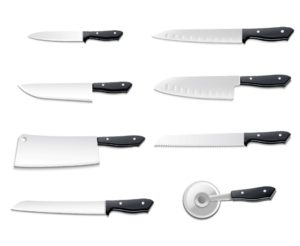Knives The Queens of the Kitchen
Knife Sovereignty in the Kitchen: Practical Advice and Materials Guide
In the hands of a chef, a knife is more than just a tool; it’s an extension of his culinary art.
Knives are the queens of the kitchen, not only because of their essential functionality, but also because of the passion and respect they arouse in cooks. The pre-preparation of ingredients, a critical stage in any culinary creation, is dominated by the use of this instrument.
Here, we explore the intimate relationship between chefs and their blades and offer an in-depth look at the materials used to make these indispensable items.
Council: The Etiquette of the Blade
Borrowing a knife from a chef is an almost taboo transgression in kitchen culture. Each chef develops a special affinity with their knives, adjusting to the weight, balance and cut of each one. If you find yourself in the rare position of borrowing a knife, treat it with the utmost respect.
Caring for the knife goes beyond maintaining a friendship; it’s a matter of honoring the chef’s craft and the instrument of his work.

Materials: Ceramic and Steel in Focus
Kitchen knives are usually forged from ceramic or steel, each with its own particularities and ideal applications.
Ceramics: The Lightweight and Durable Option
Ceramic knives are a find for the home kitchen. Their lightness is an ergonomic benefit, and their resistance to oxidation guarantees longevity for the edge. The chemical inertness of ceramic means that flavors and odors are not transferred between cut foods.
These knives are ideal companions for delicate tasks such as slicing fruit, vegetables and filleting fish. However, robustness comes at a price: ceramic can be brittle and is not suitable for heavy cuts such as meat with bones.
Steel: Versatility and Tradition
Steel remains the most traditional and versatile material for making knives.
- Carbon Steel: This alloy, loved by cutlers and aficionados, is known for the ease with which it is forged and the exceptionally sharp edge that can be achieved. However, carbon steel requires constant maintenance to prevent oxidation.
- Stainless steel: The modern choice for many kitchens, stainless steel offers a low-maintenance solution without sacrificing performance. The stainless steel knife is a reliable piece of work in any culinary environment.
- Damascus steel: The beauty of damascus steel is undeniable, with distinctive wavy patterns resulting from the tempering process. In addition to aesthetics, apricot steel is valued for its combination of hardness and flexibility, making it a favorite among chefs and collectors.
Conclusion
Choosing the right knife is as personal as it is essential in any chef’s journey.
Whether ceramic or steel, the ideal knife is one that aligns not only with the task at hand, but also with the cook’s style and preferences. While materials and care vary, respect and passion for the queens of the kitchen are universal.
In the next article, we’ll delve deeper into the fascinating world of damascus steel and discover why these knives are so prized by gourmets and collectors around the world.
See also:
– Damascus Steel in Kitchen Utensils: Art and Efficiency in Harmony
– Knives: A type for every purpose
– Knives: Care, maintenance and related utensils
– Click here to get a free “30 Basic Utensils” ebook